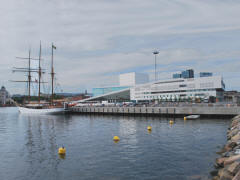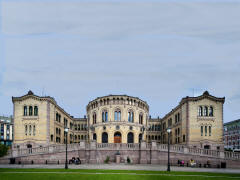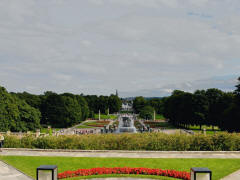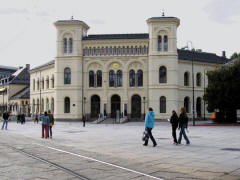|
OSLO, NORWAY Tuesday, 11 September. A pilot boarded at
6:00 a.m. to guide the ship the last 20 miles through
the beautiful Oslo Fjords, but the sun wasn't up and
skies were heavily overcast so we didn't get up for the
view. Instead we slept in, recovering
from the lack of sleep on the flight over. It was after
10:00 before we got to breakfast in the Horizon Court (a
collection of cafeterias).
The ship was docked right next to the old Akershus
Fortress (about 1300 but much modified). Norway is relatively young as an independent nation (1905). For five centuries it was joined with, and subservient to, Denmark and/or Sweeden. Although a city called Oslo was founded around 1048, it was destroyed by fire in 1624. A new city, called Christiania, was built across the bay to replace it. In 1924 Christiania was renamed Oslo. In recent years, Oslo is often ranked number one in quality of life among large cities, but it also is ranked as one of the most expensive cities in the world.
Our Oslo bus tour got off to a poor
start at 12:15 when our guide led us off the ship into a
downpour, only to find that the bus wasn't there. It
took ten minutes to arrive. Fortunately Jane and I had a
large umbrella. When we finally got started, we drove
around the walls of the Akershus Fortress and along the
shore, passing the modern Opera House (2010), a couple
of old sailing ships, and the new City Hall (1950).
Turning into the city, we passed the Parliament (Stortingent), the National Theater (1899) with a very unusual fountain, the old University campus, the Royal Palace (1848)(at a distance), the Ibsen Museum (in his last home), the U.S. Embassy (with the American flag at half mast in memory of the 9/11 attack on the World Trade Center), and the National Museum of Art (1882). At 12:40 we finally arrived at Frogner Park, site of the world famous Vigeland Sculpture Arrangement. Here we had a one hour stop. Unfortunately, the rain, which had been off and on since we left the ship, was coming down hard for the first part of our visit. Then the sun came out and the rest of the day was beautiful. The Arrangement features 212 large bronze and granite sculptures. Personally, I was more impressed with the quantity of the sculptures than their beauty. Most of the more than 200 statues, all nudes, depict people engaging in various ordinary activities, such as running, wrestling, dancing, hugging, and so on. The original plan for the Arrangement included only the fountain and the "human trees" around it, but obviously the city fathers got carried away with their enthusiasm for Vigeland's work.
The highpoint of the Arrangement now, though, clearly is the Monolith Plateau. It's a circular platform surrounded by steps lined with 36 groups of figures depicting the "circle of life." In the center at the top stands the 46 foot tall Monolith totem made up of 121 climbing bodies.
Shortly after the rain had stopped, a woman from our group lost her footing on the lower steps of the Plateau and fell backwards. Her injuries didn't seem serious, but she was taken away by ambulance. The tour was only slightly delayed. We left through the impressive iron gates, also by Vigeland, behind the Monolith Plateau.
For the rest of the day the weather was
beautiful, mostly sunny and pleasant. The bus took us to the Holmenkollen Ski Jump where we had 20 minutes on our own
to look around. There has been a ski jump on this
hill for more than a century, but the current
cantilevered jump just opened in 2010.
Our final stop was at the Norsk Folkemuseum, the world's first open air museum (1881). The guide led our group around for an hour, but it wasn't nearly enough to see this large collection of old buildings. The highlight was the Stave Church (1212) from Gol, one of the first buildings moved to the site. Imagine, a 900 year old wooden building! We've visited many open air museums, but I don't recall seeing any other wooden building so old. There were many farm buildings, some solitary and others in clusters. Except for Stave Church, our guide did not take us into any of the other buildings. We were able to explore a few small ones on our own, and in others cases we could view interiors through windows or doors.
Toward the end of our visit to the Norsk Folkemuseum, I was so busy taking photographs that I didn't notice that the rest of our group had started toward the exit. Not sure which way they'd gone, I hurried off in the wrong direction. I came upon what appeared to be an entire old village with streets and all. Unfortunately though, I didn't have time to explore it. I caught the group in the parking lot but was the last to board the bus. We left the Open Air Museum about 3:40. Going back through the city, we passed the Nobel Peace Center, opened in 2005 in the former Oslo West railway station (1872). The Center is a showcase for the Nobel Peace Prize laureates and their work. We were back at the ship by 4:00. We browsed in the shops on the pier for a short time before boarding the ship.
While were at dinner, the Captain
announced that we would not stop at Kristiansand
tomorrow as scheduled. He wanted to hurry to Scotland to
avoid rough weather we would otherwise encounter on the
way due to a hurricane in the Atlantic.
After dinner we went to the 8:30 show (a male singer) in the Princess Theater. Afterward we browsed the shipboard shops. We also caught part of the performance by a male acrobat in the Piazza before returning to our room. The ship sailed at 10:30 and was out of the Oslo Fjord about midnight.
Copyright © 2000-2023 DarrellPeck.com All rights
reserved. | |||||||||||||||||||








